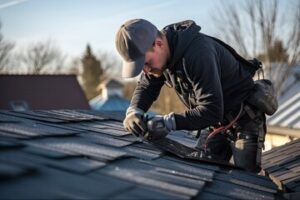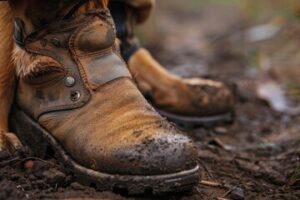A well-maintained roof is key to protecting a home from outside elements. Regular maintenance can help reduce energy costs and prevent the need for major repairs.

During roofing maintenance, contractors look for signs of damage and wear and tear. They also inspect gutters and downspouts to ensure water can flow off the roof and away from the house. Visit https://www.northportflroofing.com to learn more.
When inspecting your roof, start with the shingles. Look for shingle damage such as cracked, loose or missing. Cracked shingles will allow water to penetrate the roof and cause leaks that can affect the interior of your home. Missing shingles are also a problem, as they leave the structure of your roof exposed to the elements.
Shingles are designed with a covering of small, round rocks called granules that protect the shingles from UV light. If these granules are lost due to weather or wear, it’s a sign that the shingles are beginning to degrade and will need to be replaced.
Another thing to check for is a blueish-green staining on the shingles. This is algae, and it can eat away at the shingles and cause them to rot and leak. This can be easily fixed by spraying a 50/50 mix of water and bleach onto the roof. This will kill the algae and restore the shingles to their original state.
In addition to checking the shingles, it’s also a good idea to examine the flashing around chimneys, dormers, skylights and other roof penetrations. This is important, as it helps to prevent water leaks in those areas of the roof. It’s possible to inspect this area by looking at the underside of the shingles or by going into the attic and examining the flashing from the inside of the attic.
You should also pay attention to the condition of the attic ventilation and check the roof for signs of a lack of proper air flow. This can cause moisture to seep into the attic and the shingles and damage the insulation, leading to a decrease in indoor comfort and higher energy bills.
Other issues to look for include water stains on ceilings or walls, which could be caused by a leaky or damaged roof. In addition, you should inspect your gutters to make sure they are functional and don’t have clogs. If your gutters are clogged or damaged, rainwater will be directed onto the side of your house, which can lead to rotting wood and other problems.
Inspect the Gutters
Gutters play a key role in keeping your roof functioning properly. Installed along the edge of your roof, they direct water runoff away from the foundation of the house. Keeping gutters clear of clogs and other damage can prevent a lot of problems for your roof, home, and landscape. A regular roof maintenance check should include a visual inspection of the gutters to ensure they are working as designed.
Gutters should be cleaned twice a year during the fall and spring to remove leaves and other debris that can cause clogs. Gutter downspouts should be cleared of all obstructions and flushed to confirm proper flow. The downhill ends of the gutters should be inspected for clogs that can block water flow in freezing weather. Downspout attachment points should also be checked for corrosion or rust that could prevent the downspout from being attached correctly.
If your gutters are pulling away from the roof, or if you have holes or leaks, these are signs that they need to be repaired as soon as possible. A professional should inspect the gutters and downspouts to see what can be done to address these issues.
When you are checking the gutters, be sure to look at other higher areas of the roof and exterior of the house. Look for loose shingles, rotted trim or fascia boards, and any other areas that may need to be repaired or replaced. It is also a good time to look for signs of insect infestation. Birds’ nests and wasp nests are often easy to spot, but other insects can be harder to detect.
If you have any moss or lichen growing on your roof, this is another indication that the roof needs to be inspected. These plants can trap moisture on the roof and lead to serious water damage over time. It is important to have these removed as soon as they are noticed so that the problem does not worsen.
Check for Ice Dams
Snow-covered roofs and freezing weather are the culprits behind both beautiful icicles hanging from your home’s eaves and the thick ridges of solid ice known as ice dams. Icicles are simply a symptom of the problem; they form when snow at the peak of your roof melts, but re-freezes along the gutter edge where it meets colder air. This creates a blockage that prevents melting snow from draining off the roof and can eventually cause water to back up under the shingles, where it can leak into the attic or down walls inside the home.
Leaks from ice dams can cause significant damage to ceilings, walls, insulation and flooring. They can also promote the growth of mold and mildew, which are unhealthy for your family.
To protect your home from ice dams, you can take a proactive approach by installing heated cables or calcium chloride on the roof. These can help prevent the formation of ice dams by raising the surface temperature to the point where the ice melts. You can also reduce the risk of ice dams by keeping your trees properly trimmed, as this allows more sunlight to reach the eaves of the roof and melt snow.
Ice dams are most likely to develop in areas with frequent snowfall and large temperature fluctuations. They are more common in northern regions, but can occur anywhere there is winter precipitation and a climate that changes regularly from warm to cold.
You can prevent ice dams by removing any existing ones before they cause problems. To do this, you will need to get into the attic and look for signs of water leaking or staining. If you find any, mark the location so you can easily locate it when checking from the outside. Then, use an ice dam removal method like steaming that doesn’t require roof damage to remove the ice dams. You can do this yourself if you have access to the proper tools, or hire a professional ice dam removal company. Before you start, be sure to take a few photos of the frosty buildup on the exterior to make it easier to identify where ice dams are located once you enter your attic.
Check the Attic
The attic is a difficult space to inspect for damage. It often contains sections of the house’s HVAC system, insulation, and even storage boxes. Because water damage left unchecked can cause severe and expensive structural damage, the attic must be inspected regularly.
The most important thing to do if you find water damage in the attic is to stop it from spreading. The next step is to track down the source of the leak. This may be as simple as patching a hole in the roof or it could mean shutting off water lines to appliances and pipes. Once you’ve stopped the flow of water, you can start to repair the damage.
Moisture in the attic can damage sheathing and rafters, which support the roof. It can also lead to rot and mold. If you find mold in the attic, it must be removed as quickly as possible to avoid compromising both indoor air quality and structural integrity.
Leaks may enter the attic through holes drilled in the roof for cable, wires or vents; chimney and skylight penetrations; and roof valleys that aren’t properly sealed. Water can also enter through corroded flashing or broken shingles. In addition, a poorly ventilated attic can allow hot, moisture-laden air to infiltrate the living spaces below.
When checking the attic, be sure to wear a hard hat and clear all items out of the way to facilitate a thorough inspection. Never walk on the ceiling drywall and insulation; you can easily fall through. If you have trouble reaching some areas of the attic, a camera can help you identify problem spots from below. Also, make sure to check the depth of the insulation. Moisture laden insulation can reduce its effectiveness and contribute to energy inefficiencies in the home.

